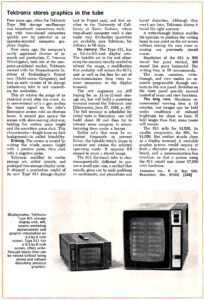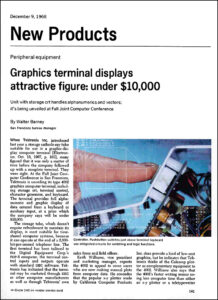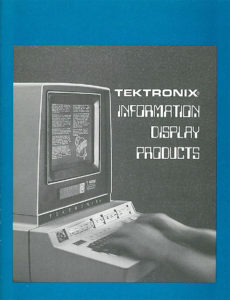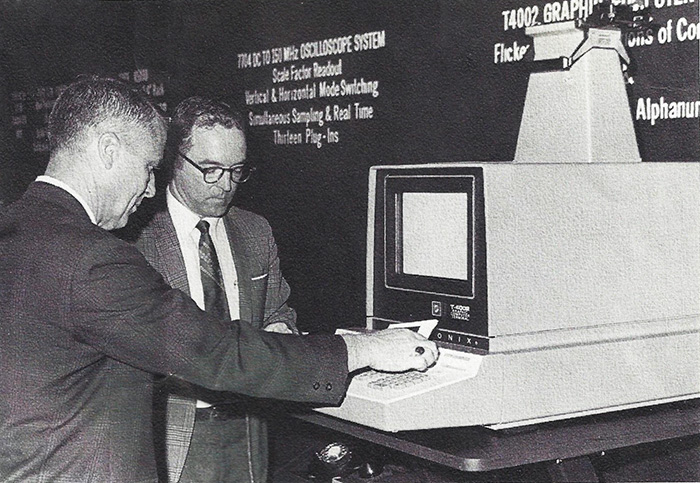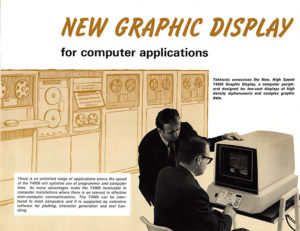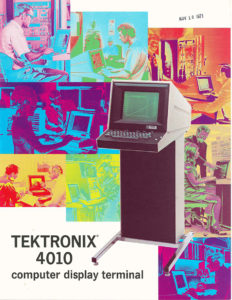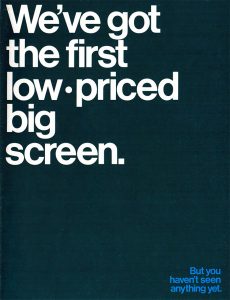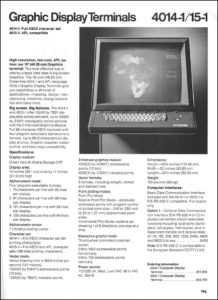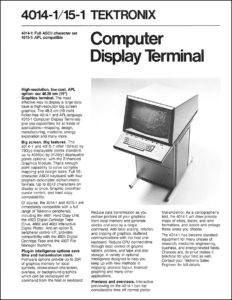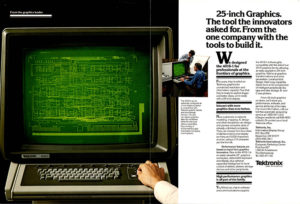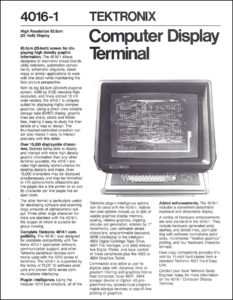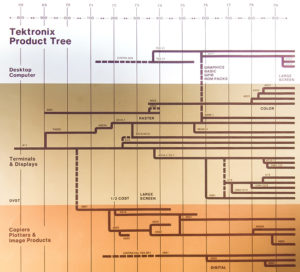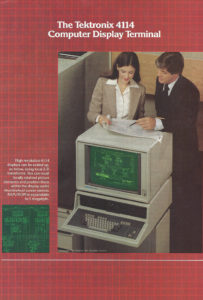Bob Anderson’s invented the bistable Direct-View Storage Tube (DVST) in 1961 and the result was the Tek 564 storage oscilloscope. Computer researchers began using hacked 564 scopes and CRTs to make desperately needed interactive computer displays – even though it was only a five inch display.
In response to this free marketing research Norman Winningstad drove an internal development to create Tek’s first non-oscilloscope business unit to deliver a storage tube monitor as the first product, the 611.
611
The 611 11" XYZ DVST display was introduced in 1967 and provided large screen capability for applications where high resolution graphics were needed. It was a perfect fit for mainframe computers used these for graphic output. This October 16, 1967 article in Electronics describes the 601 and 611 Storage Display Units. Click on the image to view the PDF.
The museum has a 611 display on exhibit with the Tektronix Logo and Wizard Generator.

Stu McNaughton, the Electrical Project Engineer for the 611, visited the museum and is holding the Engineering Instrument Specification (EIS) with his signature. We have the EIS project teams listed on our Engineering Project Teams page.
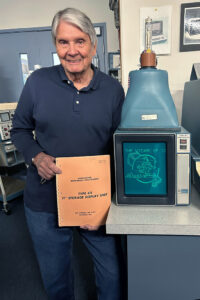
613
The 613 followed the 611 and was available in either landscape or portrait mode.
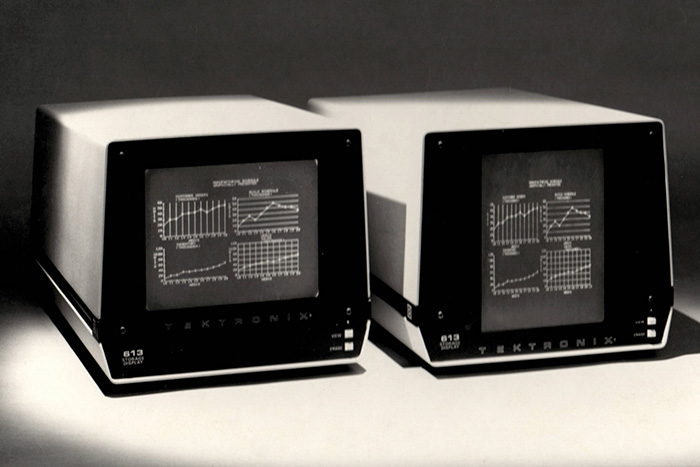
T4002
The common computer interface at the time was a teletype - basically a keyboard and a printer. Tektronix added logic to the 611 display to deliver the first low cost graphics terminal, the T4002, at a price of $8000. This January 10, 1969 Tekweek article lists the T4002 as one of the products introduced in 1968.
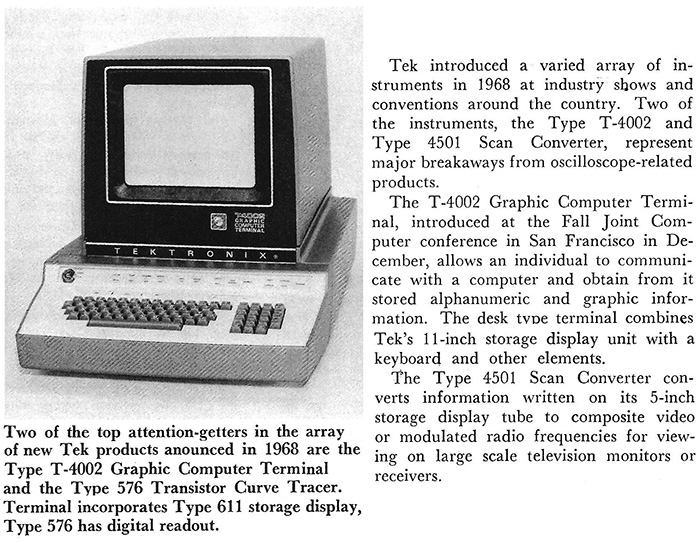
This terminal provided alphanumeric capability and high resolution graphics with a number of different computer interfaces. The protocol came to be known as "Tek Graphics" and was a 1K x 1K encoding into four ASCII characters.
Carl Machover, a pioneer of the computer graphics industry was quoted as saying: “Before the storage tube, computer graphics was a cure for no known disease – an expensive one at that. After the storage tube, computer graphics became the cure to all known disease….” (Peddie, Jon, The History of Visual Magic in Computers, Springer, 2013, p. 320)
This December 9, 1968 article in Electronics describes the T4002 terminal. Click on the image to view the PDF.
The museum has a T4002 on display. This particular terminal is a prototype and is somewhat functional. The front keyboard bezel is hand-made in the model shop so we believe this is an original T4002 prototype that was reused for the T4002A development. The "A" revision replaced a number of diode memory boards used for the character matrix with a ROM. Our T4002 is missing the A version character generator boards, front display bezel, and rear cover.
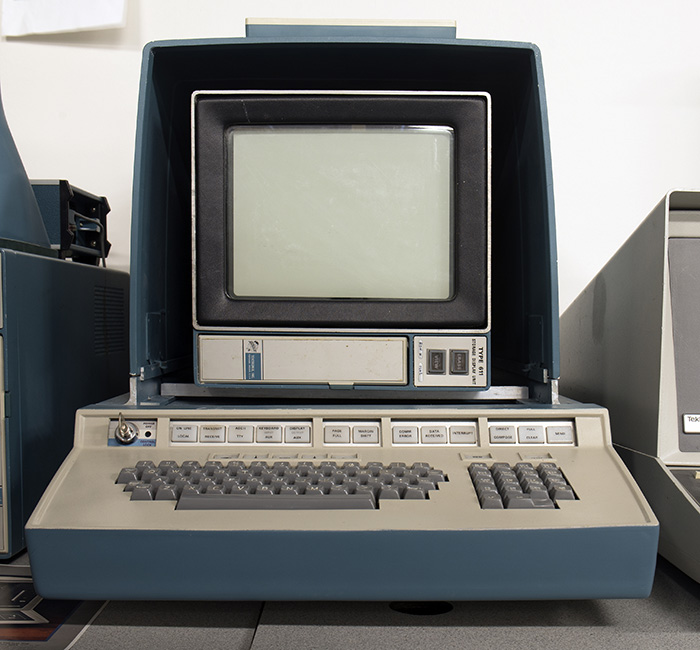
This is one of the many T4002 diode ROM PCBs.
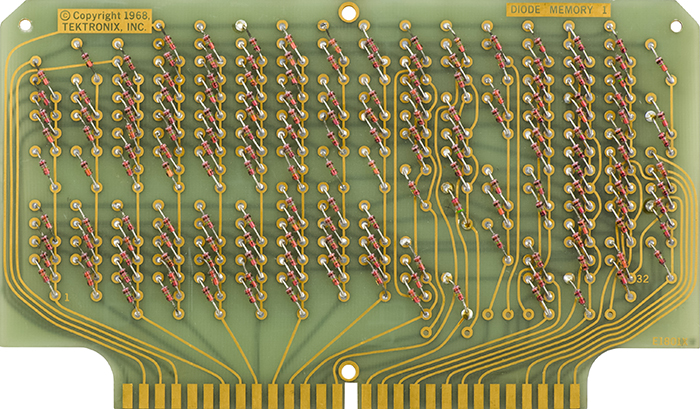
This 1970 brochure describes the T4002. Click on the image to view the PDF.
The T4002 was shown at the 1969 annual shareholders meeting as described in this September 26, 1969 Tekweek. Click on the image to view the PDF.
The T4002 was replaced by the 4002A. This May 14, 1971 TekWeek article features the introduction of the 4002A.
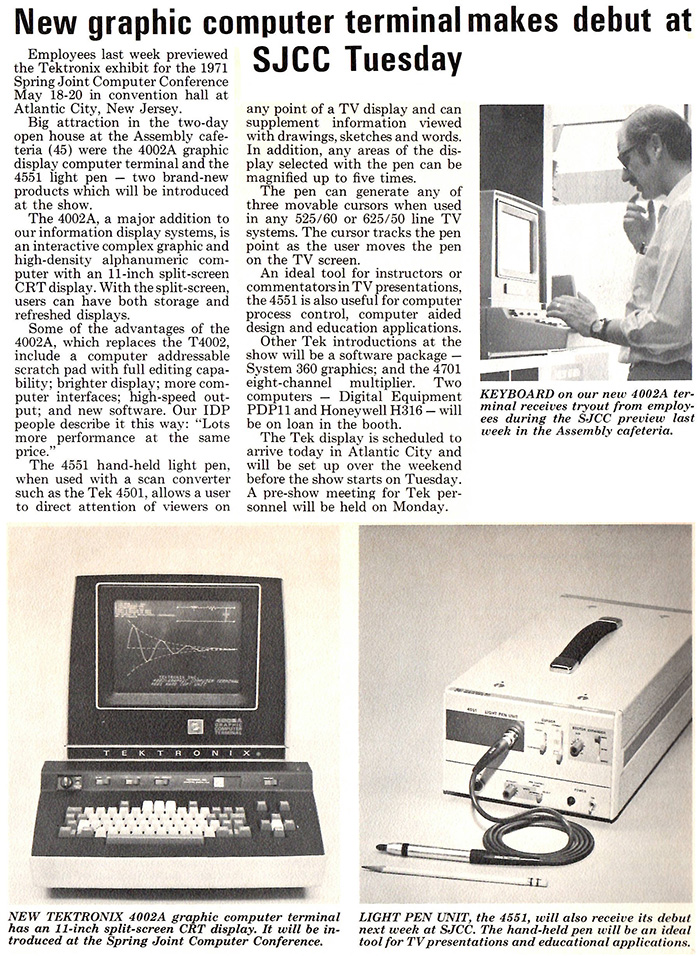
T4005
While technically more than a graphic terminal, the T4005 was an incredible product. It was introduced in 1970 and only was in production for two years. It contained an 11" DVST display and a Graphic Display Controller. The controller could drive one of 4 displays and in conjunction with software on the host computer could provide scaling, offsetting, magnifying, framing, and augmenting of the graphic output. It operated within an 8K X 8K address space and provided a simple user interface. This T4005 brochure describes some of its features. Click on the image to view the PDF.
We also have a T4005 Demonstration film on our Video Gallery.
4010
The T4002 was followed by the famous 4010 graphics terminal introduced in 1972 for a much lower price of $4250 configured with a TTY interface. The 4010 terminal provided 1024x768 resolution in a pedestal configuration. This 1971 brochure describes the 4010 features.
This 1981 photo shows Jeff Powell working on a laser wafer trimmer using a 4010 terminal.
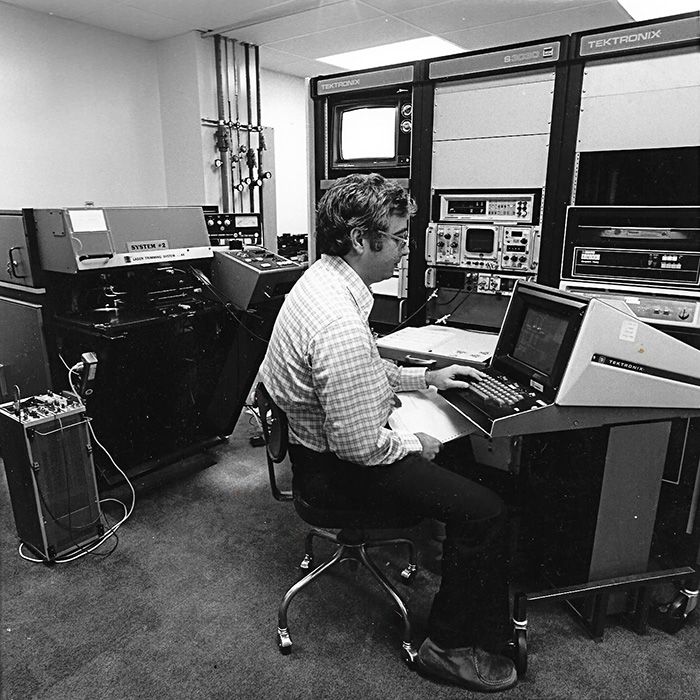
The museum has a 4010-1 on display and there is also a video of the 4010 demonstration on our Video Gallery.
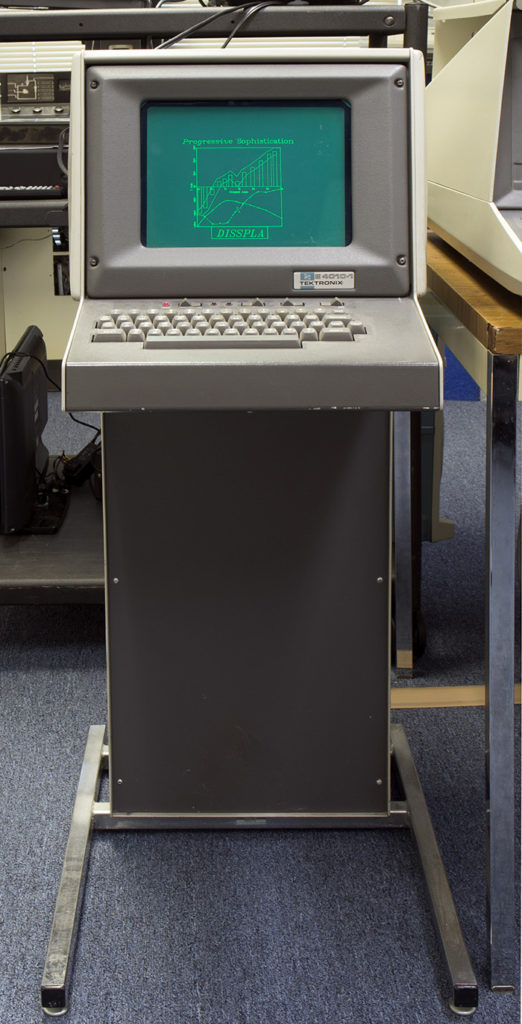
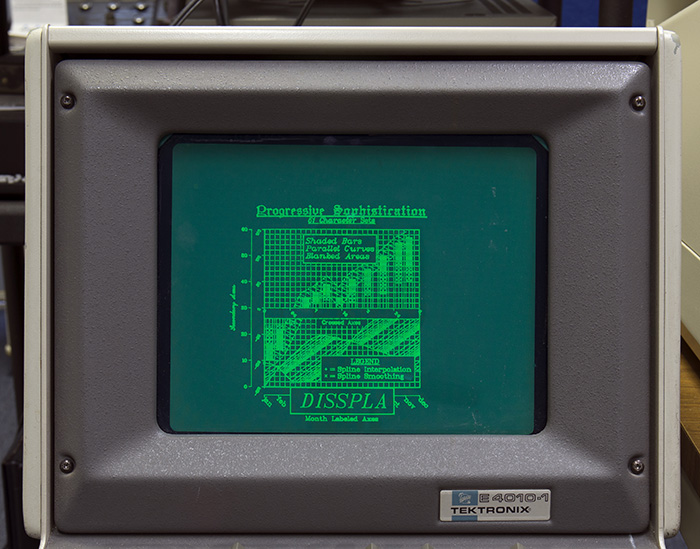
The 4010 was followed by a number of DVST graphic terminals:
4006 - low cost desktop version
4012 - lower case alpha and enhanced hard copy capability
4013 - APL character set
4014 - very popular 19" upgradable to 4096x3072 resolution
4015 - 19" with APL character set
4016 - 25" display
There is more information and brochures on our Information Display Division page including this great family photo which is high resolution in the PDF.
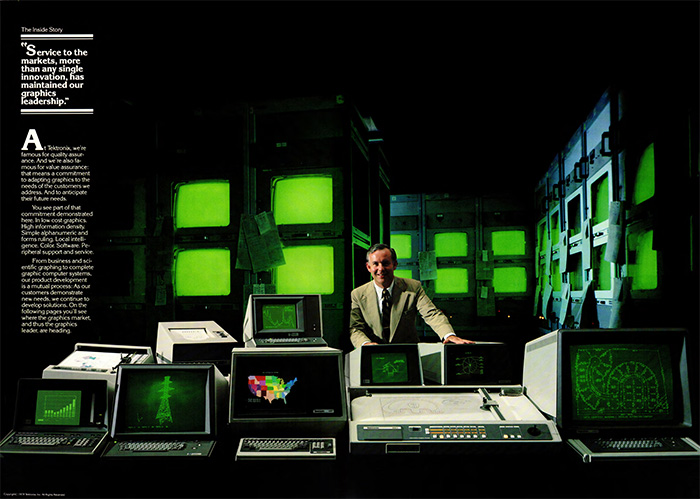
4014
The 4014 was a crowning achievement, expanding on Bob Anderson’s invention of the simplified bistable DVST in 1961. As a nineteen inch monitor with 1028 x 768 addressable pixels standard and an option to upgrade to 4096 x 3120, the 4014 offered unprecedented resolution and an optimal display size. The Tek-made 4014 CRT was fabricated using a standard television glass envelope and the same phosphor storage CRT screen process used in the 611.
The 4014 was introduced in the 1974 Tek Catalog in an understated fashion without any pictures of the product. An innovative glossy quad–fold product brochure with a tape measure and a full-size picture of the 4014 screen emphasized the viewable workspace. This brochure is also available on our Information Display Division page. Click on the image to view the PDF.
The initial catalog price was $8450 and the direct competition included IBM’s 2250 costing at least $80,000. The 4014 base price increased in all but three years of the 4014 product life from 1974 to 1984, presumably in response to market demand. A base 4014 had a catalog price of $15,750 at the end. These pages are from the 1978 catalog and datasheet. Click on the images to view the PDFs.
The museum has a 4014 on display and there is also a video of the 4014 demonstration on our Video Gallery.

4006
The 4006 represents the entry level of DVST terminals as a desktop unit with 1024 x 768 addressability. This September 26, 1975 TekWeek features the introduction.
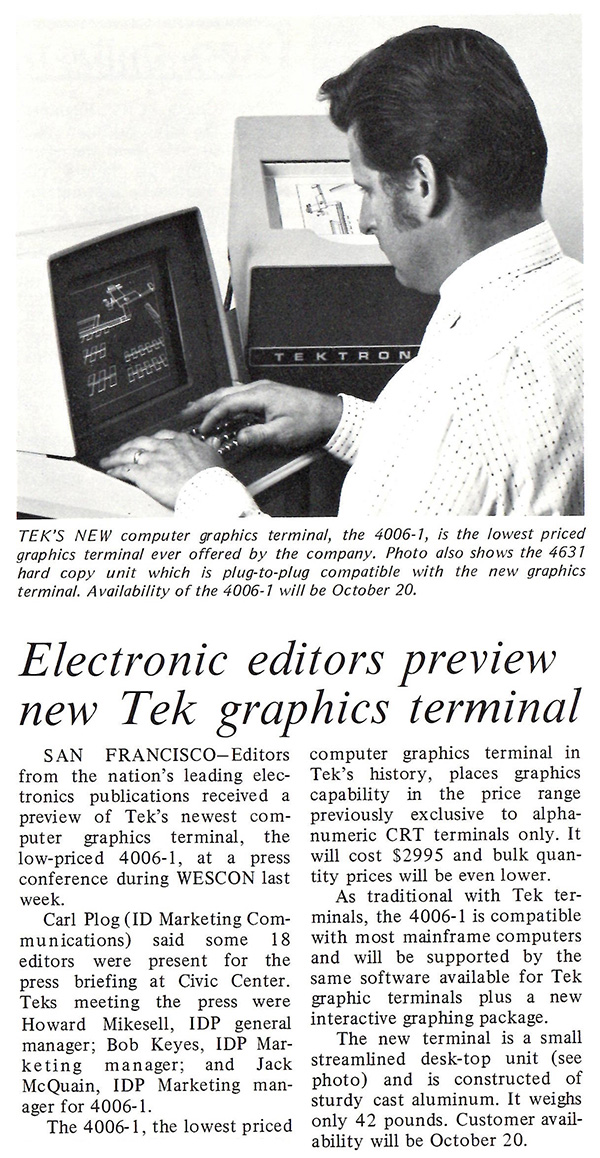
Until low cost DRAM was available in the mid 1980’s a refreshed, raster-scanned CRT was prohibitively costly. When affordable solid state memory arrived Tek’s dominance with its proprietary storage tube technology was reduced, largely due to cost and the desire for color graphics. No company was ever able to come up with a full color storage CRT design, although there was much effort in this regard.
After the storage tube and before flat panels became available, the shadow mask CRT was used for computer graphics displays, basically a higher resolution version of a design built for television in volumes of hundreds of millions per year. But these CRTs were not produced at Tek.
The dominance of Tek graphics in general and the 4014 in particular was illustrated by the fact that for almost a decade after its introduction vendors offering newer design of graphic terminals and workstations were forced to offer 4014 and Tek Plot10 software compatibility in their systems.
This brochure for the 4016 describes the features of the 25" terminal. Click on the image to view the PDF.
The museum has the 25" 4016 on display.

This 1979 brochure describes the features of the 4016. Click on the image to view the PDF.
This timeline shows the breadth and depth of the Information Display products released from 1966 to 1979. Click on the image to view the PDF.
4114
The 4114 was part of the next generation 4100 series family introduced in 1985. This generation included an 8086 microprocessor for local intelligence and local zoom and pan (through redraw), and local mass storage were some of the new features. The museum has a 4114 option 30 (desk configuration, albeit without the desk) on display.
This January 16, 2015 photo shows the first "green on the screen" during our 4114 restoration.
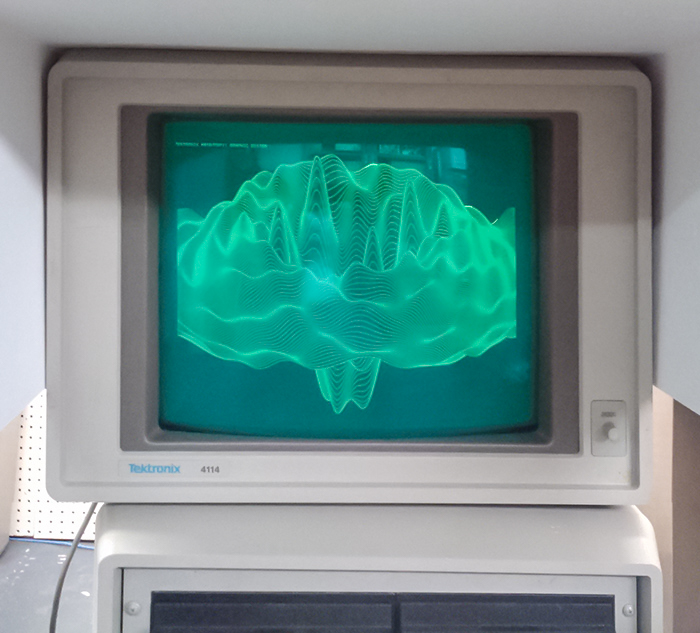
This 1981 ad features the 4114. Click on the image to view the PDF.
Other 4100 series raster (e.g. non-DVST) terminals as well as the lower cost 4200 series terminals are shown on a scan of a tablet of paper on our Information Display Division page.

